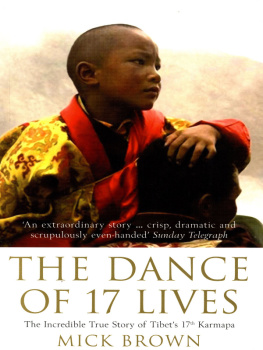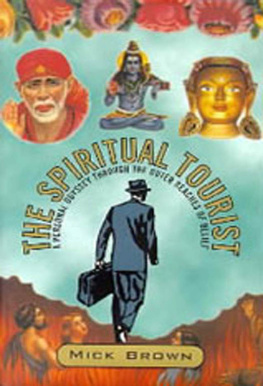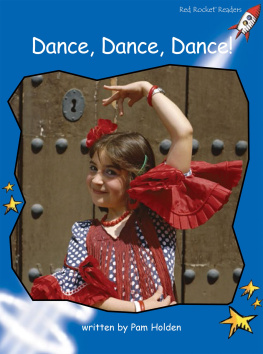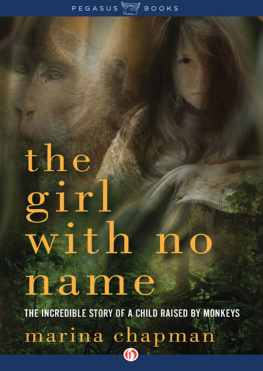Mick Brown - The Dance Of 17 Lives: The Incredible True Story Of Tibet’s 17th Karmapa
Here you can read online Mick Brown - The Dance Of 17 Lives: The Incredible True Story Of Tibet’s 17th Karmapa full text of the book (entire story) in english for free. Download pdf and epub, get meaning, cover and reviews about this ebook. year: 2004, publisher: Bloomsbury Pub Ltd, genre: Non-fiction / History. Description of the work, (preface) as well as reviews are available. Best literature library LitArk.com created for fans of good reading and offers a wide selection of genres:
Romance novel
Science fiction
Adventure
Detective
Science
History
Home and family
Prose
Art
Politics
Computer
Non-fiction
Religion
Business
Children
Humor
Choose a favorite category and find really read worthwhile books. Enjoy immersion in the world of imagination, feel the emotions of the characters or learn something new for yourself, make an fascinating discovery.
- Book:The Dance Of 17 Lives: The Incredible True Story Of Tibet’s 17th Karmapa
- Author:
- Publisher:Bloomsbury Pub Ltd
- Genre:
- Year:2004
- Rating:5 / 5
- Favourites:Add to favourites
- Your mark:
- 100
- 1
- 2
- 3
- 4
- 5
The Dance Of 17 Lives: The Incredible True Story Of Tibet’s 17th Karmapa: summary, description and annotation
We offer to read an annotation, description, summary or preface (depends on what the author of the book "The Dance Of 17 Lives: The Incredible True Story Of Tibet’s 17th Karmapa" wrote himself). If you haven't found the necessary information about the book — write in the comments, we will try to find it.
Mick Brown: author's other books
Who wrote The Dance Of 17 Lives: The Incredible True Story Of Tibet’s 17th Karmapa? Find out the surname, the name of the author of the book and a list of all author's works by series.
The Dance Of 17 Lives: The Incredible True Story Of Tibet’s 17th Karmapa — read online for free the complete book (whole text) full work
Below is the text of the book, divided by pages. System saving the place of the last page read, allows you to conveniently read the book "The Dance Of 17 Lives: The Incredible True Story Of Tibet’s 17th Karmapa" online for free, without having to search again every time where you left off. Put a bookmark, and you can go to the page where you finished reading at any time.
Font size:
Interval:
Bookmark:

THE DANCE OF
17 LIVES
THE INCREDIBLE TRUE STORY OF
TIBETS 17th KARMAPA
Mick Brown
BLOOMSBURY
To Patricia, Celeste, Dominic and Clementine
We are such stuff
As dreams are made on, and our little life
Is rounded with a sleep
Shakespeares The Tempest
CONTENTS
His Holiness the 16th Gyalwa Karmapa, Rangjung Rigpe Dorje (19231981)
The spiritual leader of the Karma Kagyu school of Tibetan Buddhism from his enthronement in 1931 until his death.
His Holiness the 17th Gyalwa Karmapa, Ogyen Trinley Dorje (1985)
The present spiritual leader of the Karma Kagyu school, who was enthroned in 1992 and escaped from Tibet into India in January 2000.
The Four Heart Sons
The principal disciples and students of the 16th Karmapa, and the main lineage holders of the Mahamudra teachings of the Karma Kagyu school. Following the death of the 16th in 1981, the four heart sons took responsibility for finding his successor. They are:
The 14th Kunzig Shamar Rinpoche, also known as the Shamarpa (1952)
The 12th Tai Situ Rinpoche, also known as the Tai Situpa (1953)
The 12th Goshir Gyaltsab Rinpoche (1954)
The 3rd Jamgon Kongtrul Rinpoche (19541992)
His Holiness the 14th Dalai Lama (1935)
The spiritual and temporal leader of Tibet until his flight into exile in India in 1959, following a popular uprising against the occupying Chinese army. He is now the leader of Tibetans in exile.
Damchoe Yongdu
The general secretary of the 16th Karmapas administration, or labrang, at both Tsurphu monastery in Tibet and Rumtek monastery in Sikkim, until his death in 1982.
Topga Yulgal
A nephew of the 16th Karmapa and a cousin of Shamar Rinpoche, who was general secretary of the Karmapas labrang at Rumtek from 1983 until 1992.
Tenzin Namgyal
Since 1992, the general secretary of the 17th Karmapas labrang at Rumtek.
Thinlay Thaye Dorje
Shamar Rinpoches contestant to the Karmapas throne.
Akong Rinpoche
Co-founder of Samye Ling monastery in Scotland.
Drupn Dechen Rinpoche
Abbot of Tsurphu monastery in Tibet from 1984 until his death in 1997.
Ole and Hannah Nydahl
Danish devotees of the 16th Karmapa, who went on to found a number of centres around the world under the name of their own organization, The Diamond Way.
His first memory is of horses. They are galloping across the plain, the sound of their hooves, he says, like thunder, their breath like plumes of smoke in the cold air. They are caparisoned in scarves and silks, their riders clad in finery. They are a wedding party, coming to celebrate the marriage of his elder sister.
Apo Gaga watches them from the opening to the tent where he lives with his parents and his eight brothers and sisters. He is three years old. By the standards of nomads in this part of eastern Tibet, the family are relatively wealthy. Apo Gagas father, Dndrub, owns eight horses, some 200 sheep and goats and between fifty and sixty yaks, enough for the familys own needs, and to trade for barley and other goods in the lowlands. The yak is the source of all that is bountiful and sustaining in the familys life. The tent in which they live in the summer months, when they drive their animals to the good pastures for grazing, is made of yak hide; the fur of the animal is used to line jackets and for blankets. Its thick, sweet, often rancid, butter is used for cooking, to flavour tea and to burn in the small lamps that surround the shrine which stands in one corner of the tent; its dung is the primary fuel for cooking, on a grate made up of piled stones, and for heating. In winter, when the snows lay thick on the ground, their animals are unable to graze and movement is difficult, the family retreat to a sturdy wooden house, built by Apo Gagas father.
Even before his birth, Apo Gaga was considered special. For years his parents had yearned for a son, but without success. And then his mother, Loga, became pregnant. During the pregnancy, Loga experienced a series of unusual indications that the child she carried was in some way extraordinary. She dreamed of three white cranes offering her a bowl of yoghurt. Resting on the bowl was a brilliant golden letter, indicating that she was expecting a boy. The cranes told her that they had been sent by Guru Rinpoche, the founder of Tibetan Buddhism, and that the boy would be a great reincarnation, but that she should keep this a secret until the right moment was revealed to her. In another dream, she saw eight auspicious symbols wreathed in rainbow light streaming out from her heart. The night before the birth, Dndrub was astonished to see rainbows over the tent, although the sun had already disappeared behind the mountains.
Shortly before sunrise the next morning, on 26 June 1985, the child was born. At that moment, a cuckoo was seen to land on the tent and burst into song, and Loga felt no pain.
Three days later, the sound of a conch shell an omen of a great birth resonated across the valley, astonishing all who heard it, for no one could be found blowing such a shell, and no conch shell could sound as loudly as this one. In the years to come, these legends will spread like ripples in a lake around his name. But for the moment Apo Gaga is treated no differently from the other children. His parents, knowing that their child is special, have not yet given him a proper name; that will be for a lama to decide. For the moment he is known as Apo Gaga happy brother the name that his sister heard a magpie call him one day as they played by the river. He follows behind his elder sisters as they look after the animals, and plays the games that all nomad children play, a gentle, sweet-natured child.
His family, like every family they know, are devout Buddhists. Thirty years of Chinese occupation and re-education in Tibet have done nothing to quash their faith. On holy days they travel to the nearest monastery, to make offerings; and sometimes a lama comes to their village, to officiate at a wedding or a festival. The children imitate lamas in play, making pujas, or prayers, building makeshift thrones from stones and taking it in turns to sit there, saying, I am a lama. And, Now its my turn. In the corner of the family home is a shrine. There is a small statue of the Buddha Shakyamuni, seven offering bowls, butter lamps, and a serchem a long-stemmed container, which sits on a copper plate, and into which black tea is poured each day as an offering to the protector deity Mahakala. Also on the shrine is a photograph of a venerable lama, a jovial, full-faced man resplendent in gold robes. This is the 16th Karmapa, one of Tibetan Buddhisms most venerated enlightened beings, who died in America a country of which Apo Gagas family have barely heard, far less visited four years before Apo Gagas birth. Dndrub has a particular connection to the 16th Karmapa. When Dndrub was a baby, his parents had taken him to see the Karmapa, who was visiting Kham, where Dndrub lived, at that time; and it was the Karmapa who had formally named him Karma Dndrub Tashi.
The seed of this link between the great lama and the nomad family has already come to fruition in a way which Dndrub and Loga could hardly dare to imagine, but if Apo Gaga is aware of this he says nothing. How could he possibly know that even as he is growing up, the followers of the Karmapa are searching for their teachers reincarnation, and that far from his home the wheels of religion and politics are turning in a way that will draw him, little Apo Gaga, inexorably into their orbit.
But by the age of seven it seems he does know. One cold, bright morning he runs to tell his parents that soon more horses will be coming, to take him away. And three days later, they come, and from that moment Apo Gagas life will never be the same again.
Next pageFont size:
Interval:
Bookmark:
Similar books «The Dance Of 17 Lives: The Incredible True Story Of Tibet’s 17th Karmapa»
Look at similar books to The Dance Of 17 Lives: The Incredible True Story Of Tibet’s 17th Karmapa. We have selected literature similar in name and meaning in the hope of providing readers with more options to find new, interesting, not yet read works.
Discussion, reviews of the book The Dance Of 17 Lives: The Incredible True Story Of Tibet’s 17th Karmapa and just readers' own opinions. Leave your comments, write what you think about the work, its meaning or the main characters. Specify what exactly you liked and what you didn't like, and why you think so.













